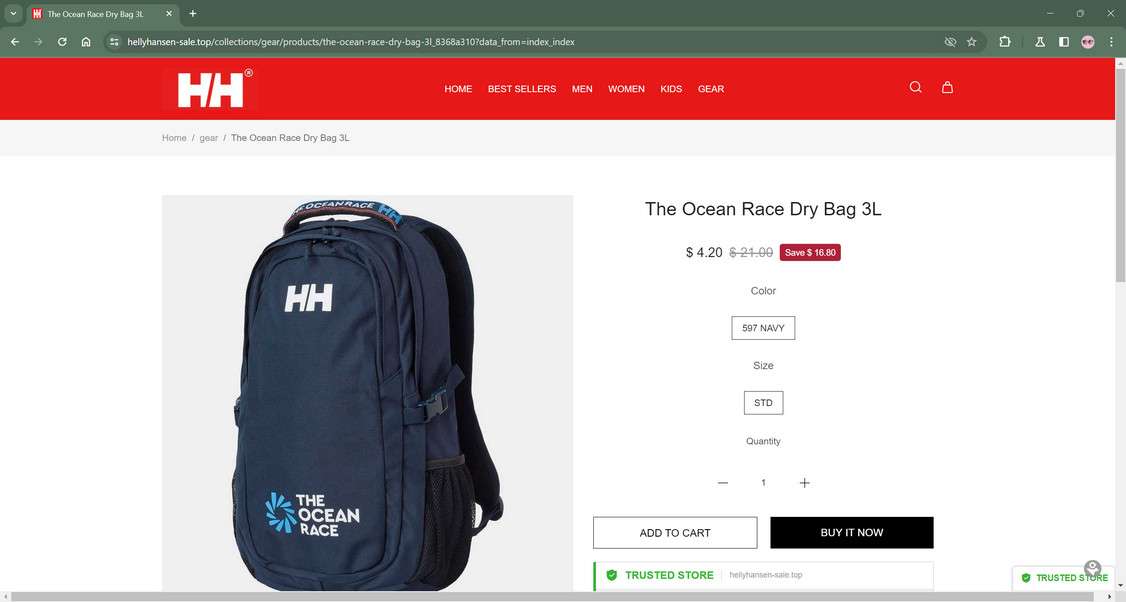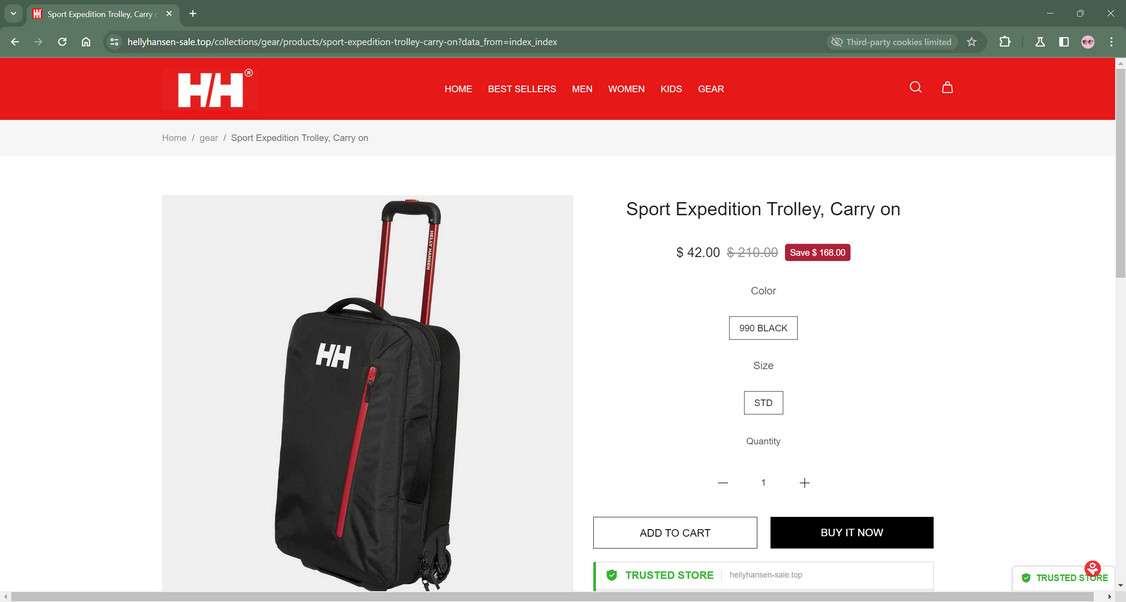Helly Hansen is a leading maker of professional grade sports and workwear trusted by athletes worldwide. However, an elaborate scam website is falsely promoting a fake “Helly Hansen Clearance Sale” with huge markdowns in order to defraud customers.
This convincing scam has already tricked many shoppers, so it’s crucial to learn how it works and avoid falling victim. Read on for everything you need to know about spotting and steering clear of Helly Hansen Clearance Sale scammer traps.



Overview of the Helly Hansen Clearance Sale Scam
The Helly Hansen Clearance Sale scam utilizes convincing fake websites engineered to closely mimic the appearance of the real Helly Hansen shopping portal. Scammers aim to exploit consumer familiarity with the Helly Hansen brand to lend credibility to their frauds.
These sophisticated sham sites advertise Helly Hansen jackets, base layers, gloves and other gear at extremely discounted clearance prices – often 60% to 90% off retail. However, the deals are only intended to trap victims rather than offer legitimate savings.
If athletes make purchases through these counterfeit sites, one of several disappointing outcomes typically occurs:
- No products are ever shipped after payments clear
- Cheap knockoffs made with inferior materials are sent instead
- Used, damaged or tampered gear arrives rather than new items
- Completely random products show up unrelated to the order
Besides not delivering as promised, these scam portals also harvest users’ personal and payment details during checkout to facilitate identity theft and credit card fraud.
The Helly Hansen Clearance Sale scam is operated by an organized cybercriminal group based out of China that manages a network of fraudulent stores to scam sports enthusiasts globally.
How the Helly Hansen Clearance Sale Scam Works
The criminals running this scam have optimized how to closely imitate genuine shopping websites and entice victims:
Step 1: Engineer Highly-Realistic Fake Website
First, the scammers setup hosting infrastructure and register deceptive domain names incorporating Helly Hansen’s actual brand assets to build out fake portals with incredible authenticity.
Helly Hansen’s logos, product images, web copy, customer testimonials and site templates are aggregated from various legitimate company sources to assemble counterfeit pages appearing genuine.
To encourage immediate purchases, scam pages showcase merchandise at 60-90% off MSRP alongside slogans like “Clearance prices won’t last!” and “Going out of business sale!”.
Step 2: Market Fake Site Extensively
Once built, ads for the scam Helly Hansen website are blasted across numerous channels – from sketchy sponsored blog posts to video ads on Facebook and Instagram – to drive shopper traffic.
Video ads highlight the extreme deals using urgent captions around flash sales ending very soon to prompt quick orders before athletes scrutinize the store too closely.
Step 3: Harvest Customer Payment & Personal Data
Victims land on polished, functional online store templates containing stolen Helly Hansen brand assets and assume the site is legitimate without comparing URLs or validation certificates. Too-good-to-pass-up discounts distract from investigating further.
At checkout, personal info like names, addresses and phone numbers are collected alongside financial data including credit card numbers, security codes and expiration dates – everything identity thieves need.
Step 4: Process Payments & Disappear
After payments clear, unsurprisingly no orders ship nor does purchased gear ever arrive. Automated fake shipping notifications send to victims to delay alarm until maximum funds can be extracted, after which point fraud operations wind down.
By managing each phase strategically in sequence, networks operate these stings at scale for months reaping substantial profits before sites are flagged.
Red Flags of the Helly Hansen Clearance Sale Scam
While easy to initially be fooled by slick websites and tempting deals, studying these subtle suspicious signals can prevent being scammed:
- Extreme discounts of 90%+ should make shoppers highly skeptical of sales
- Missing phone numbers, physical addresses and other standard contact methods
- Identical privacy policies, terms of use and about us pages pointing to template sites
- Slight differences in domain names and URL spellings from real Helly Hansen portal
- No business registration or ownership details provided whatsoever
- Demands unsafe payment methods like bank wires, gift cards or cryptocurrency
- Spelling/grammar errors suggesting non-native English speaking operators
- Complete lack of independent reviews, certifications or community references
If anything raises suspicions, trust intuition and avoid the site rather than risk hard-earned money. Following up to validate clearance sales often exposes them as total shams.
How to Spot This Scam on Social Media
A pivotal element of this scam involves promoting fraudulent discounts through social media ads and posts. Here’s what to watch for on key platforms:
- Watch for video ads in feeds showcasing Helly Hansen gear while overlaying text about clearance sales ending in 24 hours.
- Be doubtful of sponsored posts urging readers to “take an extra 60% off all sale styles now!” before exaggerated deadlines.
- Click “Why am I seeing this” on questionable ads. Transparency sections showing real brand details indicate legitimate promotions.
- Fake Facebook pages also mimic Helly Hansen’s official handles and run scam clearance sale ads. Compare page creation dates and URLs to identify impersonators.
- Scam Instagram accounts impersonating Helly Hansen promote similar video ads linking to their fake discounted sites, viewable by tapping the account profile.
- Such ads use urgency tactics claiming “today only!” extra markdowns on rarely discounted bestselling cold weather essentials.
- Besides ads, these counterfeit Helly Hansen accounts also make regular feed posts announcing “flash deals” while incorporating lifted logos and product visuals.
- No contact info, company background or main office address can be verified on the scam profiles or linked websites.
TikTok
- Video ads demonstrate Helly Hansen jackets with custom graphics highlighting huge clearance markdowns, said to expire within hours.
- Music trends, popular sounds and funny captions tactically divert attention from suspicious links while baiting engagement.
- No ad transparency showing paying sponsors can be spotted – indicating avoidance of scrutiny common among TikTok commerce scams.
- Comments are also disabled on sham branded accounts, blocking criticisms or scam calls-outs from genuine followers.
Scrutinizing social channels’ ad transparency features while double-checking seller details on linked websites remains vital to modern digital safety. Verify before trusting deals that feel off.
What to Do if You Were Scammed
If you made purchases through a fake Helly Hansen clearance website that never fulfilled orders or delivered illegitimate products, quickly take these steps:
Report Fraudulent Charges
Contact your bank and payment providers used on the scam website. Ask that they initiate billing disputes and begin fraud investigations into reversing the unauthorized charges. Provide details on how the retailer misled customers.
Monitor Accounts Closely
Keep close watch on financial accounts and payment methods used on the scam site in case delayed criminal usage occurs. Identity thieves occasionally hold stolen payment card data for months before employing it in batches once banks drop guard. Report any unauthorized transactions immediately.
Address Security Risks
Reset passwords on accounts potentially exposed by reusing similar credentials entered on scam sites. Enable two-factor authentication on key logins around financial, email and social media accounts as an extra security layer. Update passwords routinely going forward.
File Complaint Reports
Report fake website details, transactions, screenshots and losses to agencies like the FBI’s Internet Crime Complaint Center (IC3) and Federal Trade Commission to aid law enforcement in combating larger scam networks.
Leave Scam Warnings Online
Post scam alerts on outdoor gear forums, seller review sites, and other online locations where unsuspecting customers may encounter fraudulent Helly Hansen stores or clearance advertisements. Explicit warnings help prevent repeat victimization.
Explore Legal Options
For high-loss fraud cases, consulting an attorney well-versed in consumer cybercrime matters may provide civil litigation or criminal restitution options depending on state laws and gathered evidence. An initial consultation often helps determine feasibility.
Swift disputes and damage control aids scam victims, while warning sites and fellow shoppers prevents further victimization at the hands of convincing clearance sale fraudsters.
Frequently Asked Questions on the Helly Hansen Clearance Scam
Getting tricked by fraudulent Helly Hansen sales has left many shoppers confused. Here are answers addressing key questions on this convincing scam.
Does the premium Helly Hansen brand actually offer clearance sales?
No. As an athletic and workwear company not reliant on brick-and-mortar outlets, Helly Hansen has no need to liquidate overstock items through mass markdowns on its official website. Beware of any online retailer claiming year-round Helly Hansen sales up to 90% off.
How can I determine if a website is a real or fake Helly Hansen store?
Authentic Helly Hansen online stores use official company domains like HellyHansen.com. Scam sites use slightly altered spellings. Additionally, real Helly Hansen websites post working customer service phone numbers clearly on each page and provide full legitimate business details. Fraudulent stores lack transparency or use placeholder contacts. Comparing site assets also reveals scam plagiarism.
Could I get scammed ordering directly via HellyHansen.com?
Shopping directly through HellyHansen.com or their verified social media pages ensures you interact only with real company representatives. As with any major retailer, only enter payment info at secure online checkout flows protected by SSL encryption, denoted by https:// and padlocks in the URL bar. This keeps data secure.
Why do scammers heavily promote fake Helly Hansen sales on social media?
Scammers leverage Facebook, Instagram and TikTok to blanket target athleisure consumers with ads linking to their fake discounted Helly Hansen stores. Impersonator social accounts also directly message followers fraudulent “deal” links. These predominantly utilize video showcasing Helly Hansen gear while overlaying graphics about deals expiring shortly to pressure urgency over scrutiny.
My friend got scammed by a fake Helly Hansen website – what next steps should they take?
Firstly, call banks to halt charges and reverse any possible payments to limit financial damages. Monitor accounts closely over the next 6-12 months for potential fraud emerging later and reset exposed passwords immediately. Report fake sites to multiple agencies while warning contacts also reached by scam social posts. For high losses, legal options may help seek restitution based on state laws.
Staying informed around professional ecommerce scam methods remains every shopper’s best self-defense against the endless creativity of fraudsters aiming to exploit human trust and excitement around perceived deals and discounts. Verify offers directly with brands before engaging.
Conclusion
The Helly Hansen Clearance Sale scam offers another sobering view of how far modern online fraud operations have progressed using social engineering and fake websites. By reviewing their latest techniques however, shoppers can empower themselves to spot fraudulent discounts and deceptive retailers. Staying informed on cyberthreat innovations and cross-checking details remains our greatest defense against fast-evolving digital scam threats. Protect identity and savings at all costs.










